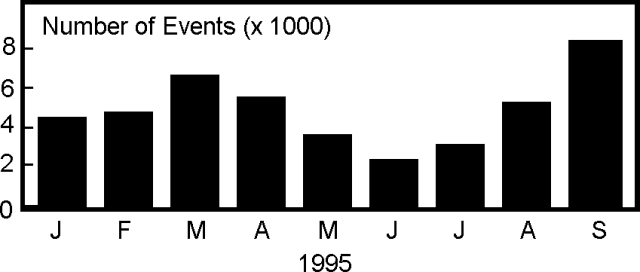Report on Poas (Costa Rica) — September 1995
Bulletin of the Global Volcanism Network, vol. 20, no. 9 (September 1995)
Managing Editor: Richard Wunderman.
Poas (Costa Rica) Over 9,000 seismic events in September, most of them low-frequency; no tilt
Please cite this report as:
Global Volcanism Program, 1995. Report on Poas (Costa Rica) (Wunderman, R., ed.). Bulletin of the Global Volcanism Network, 20:9. Smithsonian Institution. https://doi.org/10.5479/si.GVP.BGVN199509-345040
Poas
Costa Rica
10.2°N, 84.233°W; summit elev. 2697 m
All times are local (unless otherwise noted)
During September, 9,144 seismic events took place, the most for any month in 1994 or thus far in 1995. These events were predominantly low-frequency (8,854 events, figure 58);
 |
Figure 58. Low-frequency seismicity at Poás, January-September 1995. Data were collected at station POA2 located 2.7 km SW of the active crater. Courtesy of OVSICORI-UNA. |
The level of the sky blue lake within the N crater climbed 0.6 m in September with respect to August. The lake's temperature was 34°C. Fumaroles on the W lake terrace increased their output, but they only generated gas columns <50 m high. Although weaker than these fumaroles, two new fumaroles appeared on the terrace to the NW and SW of the lake. Other new fumaroles were seen along the N wall of the pyroclastic cone; fumarolic gases discharging from the cone reached 93°C. Constant bubbling continued to issue from points in the central and W lake. The fumarolic area on the SW and S wall maintained a 90-95°C temperature and discharged gas columns that rose as high as 100 m. Mass wasting of unstable hydrothermally altered rocks in this area covered some fumarolic vents and opened new ones.
Geological Summary. The broad vegetated edifice of Poás, one of the most active volcanoes of Costa Rica, contains three craters along a N-S line. The frequently visited multi-hued summit crater lakes of the basaltic-to-dacitic volcano are easily accessible by vehicle from the nearby capital city of San José. A N-S-trending fissure cutting the complex stratovolcano extends to the lower N flank, where it has produced the Congo stratovolcano and several lake-filled maars. The southernmost of the two summit crater lakes, Botos, last erupted about 7,500 years ago. The more prominent geothermally heated northern lake, Laguna Caliente, is one of the world's most acidic natural lakes, with a pH of near zero. It has been the site of frequent phreatic and phreatomagmatic eruptions since an eruption was reported in 1828. Eruptions often include geyser-like ejections of crater-lake water.
Information Contacts: E. Fernandez, E. Duarte, R. Saenz, W. Jimenez, and V. Barboza, Observatorio Vulcanologico y Sismologico de Costa Rica, Universidad Nacional (OVSICORI-UNA), Apartado 86-3000, Heredia, Costa Rica.

